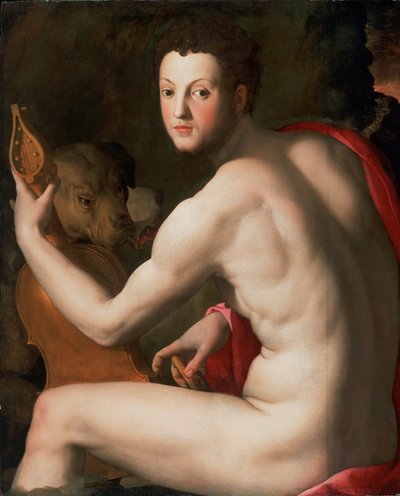Among the Mannerists, Agnolo Bronzino was one of the most outstanding portrait painters. Like his colleagues, he mixed styles of the High Renaissance with the early Baroque. Bronzino's paintings are considered "icy″ portraits because they create a gap between the sitter and the viewer, which can seem cold at times.
The name Bronzino was a nickname probably based on the preferred dark color scheme of Agnolo's paintings. Born in the tranquil village of Monticello near Florence, Agnolo die Cosimo spent most of his life and work in the dazzling metropolis of Florence, which was then one of the most important art cities in the world. Unlike many other artists of the time, who often took travel for granted as a working process among artists, Bronzino rarely left the city and was very much tied to his home.
He completed his apprenticeship as an artist with one of the founders of Florentine Mannerism, Jacopo Pontormo. He in turn was a master student of painting greats Michelangelo and Leonardo da Vinci. These considerable influences are still evident in Bronzino works.
In 1522, the plague broke out in Florence. Bronzino fled to a nearby monastery. But even in the place of rest, he did not tire of continuing to work despite the precarious circumstances. Together with his former teacher, he produced a series of frescoes for the church. As an honored collaborator of the Duke and under the patronage of the Tuscan Duke Cosimo de Medici, he had a great influence on the Florence art scene. Among the important paintings he produced for his patrons were the portraits painted on the occasion of the Duke's wedding to Eleonora di Toledo. These earned Bronzino the reputation of being a master in the field of stylish portraiture. A delicate coldness and almost aloof presence surround his painted figures.
Although Bronzino's style has been called academic art, it did not lack creative and poetic elements. These aspects are well seen in his portrait of a Genoese admiral, whom Bronzino imaginatively depicted as Neptune, the imposing god of the sea. Bronzino's works continued to influence portrait painters throughout Europe centuries later.
×





.jpg)
.jpg)
.jpg)
.jpg)
.jpg)
.jpg)
.jpg)
.jpg)
.jpg)
.jpg)
_-_(MeisterDrucke-36929).jpg)
_-_(MeisterDrucke-36929).jpg)
.jpg)
.jpg)
.jpg)
.jpg)
.jpg)
.jpg)
_-_(MeisterDrucke-1090762).jpg)
_-_(MeisterDrucke-1090762).jpg)
.jpg)
.jpg)
_-_(MeisterDrucke-1092059).jpg)
_-_(MeisterDrucke-1092059).jpg)
 - (MeisterDrucke-636143).jpg)
 - (MeisterDrucke-636143).jpg)
.jpg)
.jpg)
.jpg)
.jpg)
.jpg)
.jpg)
_-_(MeisterDrucke-897998).jpg)
_-_(MeisterDrucke-897998).jpg)
.jpg)
.jpg)
.jpg)
.jpg)
.jpg)
.jpg)
.jpg)
.jpg)
.jpg)
.jpg)
.jpg)
.jpg)
.jpg)
.jpg)
.jpg)
.jpg)
.jpg)
.jpg)
_-_(MeisterDrucke-985612).jpg)
_-_(MeisterDrucke-985612).jpg)
.jpg)
.jpg)
.jpg)
.jpg)
.jpg)
.jpg)
.jpg)
.jpg)


.jpg)
.jpg)
.jpg)
.jpg)
_-_(MeisterDrucke-432191).jpg)
_-_(MeisterDrucke-432191).jpg)
 - (MeisterDrucke-124342).jpg)
 - (MeisterDrucke-124342).jpg)
.jpg)
.jpg)
.jpg)
.jpg)
.jpg)
.jpg)
_The_Madonna_and_Child_with_Saint_John_the_Baptist_an_-_(MeisterDrucke-939162).jpg)
_The_Madonna_and_Child_with_Saint_John_the_Baptist_an_-_(MeisterDrucke-939162).jpg)
.jpg)
.jpg)
 (Ferdinand I Grand Duke of Tuscany) - (MeisterDrucke-60245).jpg)
 (Ferdinand I Grand Duke of Tuscany) - (MeisterDrucke-60245).jpg)
 engraved by Rafaello Morgan (1758-1833) in 1795 - (MeisterDrucke-77385).jpg)
 engraved by Rafaello Morgan (1758-1833) in 1795 - (MeisterDrucke-77385).jpg)
_known_as_Cosimo_the_Old_Medici_(1389-1464)_-_(MeisterDrucke-961085).jpg)
_known_as_Cosimo_the_Old_Medici_(1389-1464)_-_(MeisterDrucke-961085).jpg)
.jpg)
.jpg)
.jpg)
.jpg)
.jpg)
.jpg)
.jpg)
.jpg)
_-_(MeisterDrucke-73399).jpg)
_-_(MeisterDrucke-73399).jpg)
.jpg)
.jpg)
 - (MeisterDrucke-230046).jpg)
 - (MeisterDrucke-230046).jpg)
.jpg)
.jpg)
_(1421-1463)_Banker_and_-_(MeisterDrucke-948252).jpg)
_(1421-1463)_Banker_and_-_(MeisterDrucke-948252).jpg)
.jpg)
.jpg)
.jpg)
.jpg)
.jpg)
.jpg)
 - (MeisterDrucke-108616).jpg)
 - (MeisterDrucke-108616).jpg)
.jpg)
.jpg)
.jpg)
.jpg)
.jpg)
.jpg)
 as a Young Boy 1551 (tempera on panel) - (MeisterDrucke-40120).jpg)
 as a Young Boy 1551 (tempera on panel) - (MeisterDrucke-40120).jpg)
.jpg)
.jpg)
_(Jules_de_medicis_ou_giulio_de_medici)_(_-_(MeisterDrucke-988500).jpg)
_(Jules_de_medicis_ou_giulio_de_medici)_(_-_(MeisterDrucke-988500).jpg)
.jpg)
.jpg)
.jpg)
.jpg)
_daughter_of_Cosimo_I_of_Tuscany_(Cosimo_I_-_(MeisterDrucke-960898).jpg)
_daughter_of_Cosimo_I_of_Tuscany_(Cosimo_I_-_(MeisterDrucke-960898).jpg)
_Painting_by_Agnolo_di_Cosimo_di_Mariano_dit_-_(MeisterDrucke-947313).jpg)
_Painting_by_Agnolo_di_Cosimo_di_Mariano_dit_-_(MeisterDrucke-947313).jpg)
.jpg)
.jpg)
.jpg)
.jpg)
.jpg)
.jpg)
.jpg)
.jpg)
.jpg)
.jpg)
.jpg)
.jpg)
.jpg)
.jpg)
.jpg)
.jpg)
.jpg)
.jpg)
 - (MeisterDrucke-107693).jpg)
 - (MeisterDrucke-107693).jpg)
_-_(MeisterDrucke-376738).jpg)
_-_(MeisterDrucke-376738).jpg)
.jpg)
.jpg)
_-_(MeisterDrucke-897920).jpg)
_-_(MeisterDrucke-897920).jpg)
.jpg)
.jpg)
_(John_of_Medici_-_(MeisterDrucke-1002349).jpg)
_(John_of_Medici_-_(MeisterDrucke-1002349).jpg)
_(Giuliano_de_Medici)_Duke_of_Nemours_P_-_(MeisterDrucke-947596).jpg)
_(Giuliano_de_Medici)_Duke_of_Nemours_P_-_(MeisterDrucke-947596).jpg)
.jpg)
.jpg)
.jpg)
.jpg)
.jpg)
.jpg)
.jpg)
.jpg)
 - (MeisterDrucke-71533).jpg)
 - (MeisterDrucke-71533).jpg)
.jpg)
.jpg)
_-_(MeisterDrucke-225161).jpg)
_-_(MeisterDrucke-225161).jpg)
.jpg)
.jpg)
.jpg)
.jpg)
.jpg)
.jpg)
.jpg)
.jpg)
_-_(MeisterDrucke-122145).jpg)
_-_(MeisterDrucke-122145).jpg)
.jpg)
.jpg)
_-_(MeisterDrucke-908628).jpg)
_-_(MeisterDrucke-908628).jpg)
_-_(MeisterDrucke-316757).jpg)
_-_(MeisterDrucke-316757).jpg)
.jpg)
.jpg)
_de_Medici_-_(MeisterDrucke-1463887).jpg)
_de_Medici_-_(MeisterDrucke-1463887).jpg)




